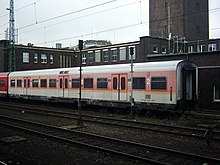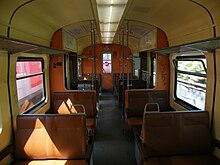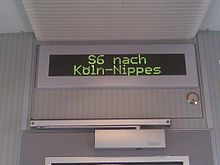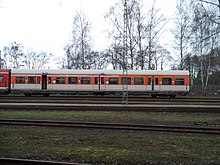x car
| x car | |
|---|---|
|
Control car Bxf 796
|
|
| Numbering: | Middle car 1./2. Class: ABx 791 middle car, 2nd class: Bx 794 control car, 2nd class: Bxf 796 |
| Number: | 121 × ABx 791 193 × Bx 794 118 × Bxf 796 |
| Manufacturer: | MBB and DUEWAG |
| Year of construction (s): | 1978-1998 |
| Retirement: | since 2009 few, since 2014 in larger numbers |
| Axis formula : | 2'2 ' |
| Gauge : | 1435 mm ( standard gauge ) |
| Length over buffers: | Control car: 25,260 mm Middle car: 24,500 mm |
| Height: | Control car: 4,002 mm above the SO Intermediate car: 3,852 mm above the SO |
| Width: | 2,870 mm |
| Trunnion Distance: | 17,500 mm |
| Bogie axle base: | 2,500 mm |
| Smallest bef. Radius: | coupled 150 m, uncoupled 80 m |
| Empty mass: | Control car: 31,100 kg Middle car: 28,000 kg |
| Top speed: | 140 km / h |
| Impeller diameter: | 730 mm |
| Brake: | KE air disc brake |
| Train control : | PZB I 60 R, system PZB 90 |
| Train heating: | electric |
| Control: | Time-multiplex push-pull train control , frequency-multiplex train control |
| Seats: | Bxf 796: 62 ABx 791: 32 (1st) + 48 (2nd) Bx 794: 80 |
| Standing room: | Bxf 796: 105 ABx 791: 104 Bx 794: 110 |
| Floor height: | 1,000 mm above SO |
| Low floor: | 0% |
In x-car is cars for commuter trains in Germany . The wagons are usually put together as fixed push-pull trains that are not separated during operation and are therefore treated like a multiple unit . They were developed for the Rhein-Ruhr S-Bahn , where they have not been used since December 2019. So today they are only in operation with the Nuremberg S-Bahn . For a short time in the summer of 2002 they were also used on the Berlin S-Bahn ; from the end of July 2009 to the beginning of 2011 this was the case again.
history

Development and construction
The Rhein-Ruhr S-Bahn was first opened in 1967 with locomotive-hauled trains, which consisted of n-cars and class 141 electric locomotives . Mid-1970s, the company was then railcars of class 420 changed. However, they were not completely satisfactory on the Rhine and Ruhr, in particular the inadequate comfort was criticized; The trains were actually not designed for the long distances between the stations on the routes in the Ruhr area. At first they thought about a variant of the 420 series with the working title 422, but ultimately decided on a locomotive hauled train.
In 1978, the manufacturers DUEWAG and MBB received an order from the Deutsche Bundesbahn to develop a Rhine-Ruhr push-pull train . As a train was electric locomotives of the 111 series are provided. The end of the first have already prototypes of second- class cars Bx 794.0 and the driving trailer type 796.0 bxf submitted for testing to the Federal Railways. The first / second-class cars AB x 791.0 followed early 1979. Strikingly closely resemble the x-car never made it to the finish designs for the 422 (old), a variant of the 420 or with power Wi intermediate cars . Technically, the x-wagons are also very much based on the LHB local transport wagons developed three years earlier , of which u. a. Bogies, many design elements and the heating / ventilation concept have been adopted.
In 1981 the x-wagons went into series production with only minor changes and replaced the 420 series on the Ruhr. The series built until 1984 comprised 59 ABx and Bxf as well as 97 Bx . In 1989, a second series of 13 ABx 791.2 and Bxf 796.2 and 19 Bx 794.2 was procured for network expansion . These vehicles were painted at the factory in the then new DB color scheme for S-Bahn and differ in details from the previous series. For the new Nuremberg S-Bahn it was decided in 1988 to also use x-wagons, but together with class 141 locomotives. For this purpose, a series of 9 ABx 791.3 and Bxf 796.3 and 23 Bx 794.3 each was procured in 1991/92 . Most recently, in 1995, another x-car was built for the Rhine-Ruhr S-Bahn. There are 19 ABx 791.4 , 21 Bxf 796.4 and 3 Bx 794.4 . Then the decision was made to replace the cars with new electric multiple units in the next few years. After the class 423 multiple unit was never used in the originally intended numbers in the Ruhr area, worn x-car sets have been replaced by the 422 class, which was further developed from the 423 class .
| Years of construction | ABx 791 | Bx 794 | Bxf 796 | comment | Manufacturer |
|---|---|---|---|---|---|
| 1978-1979 | 3 | 4th | 3 | Prototypes | DUEWAG / MBB |
| 1981-1984 | 59 | 97 | 59 | 1st series | DUEWAG / MAN |
| 1989 | 13 | 19th | 13 | 2nd series | DUEWAG / MAN |
| 1991-1992 | 9 | 23 | 9 | 3rd series for the Nuremberg S-Bahn | MAN |
| 1995 | 19th | 30th | 21st | 4th series | DWA Bautzen |
In 2011/2012, 48 third and fourth series cars, including 12 control cars, were modernized for the Nuremberg S-Bahn at the Nuremberg plant. In addition to a new paint job on the inside and outside, you will also receive new seat cushions, the control car also a mobile ramp for wheelchairs. Eight ABx wagons of the third and four of the fourth series were converted into pure second class wagons, they now have the type designation 794.5 and 794.6. The modernized cars have been in full use on the S 2 line since July 2012.
In use since December 2014
The x-car trains with locomotives of the class 143 were completely replaced by railcars of the class 422 in double traction on the S 6 of the Rhein-Ruhr S-Bahn in December 2014. The latter became free because new Alstom trains of the 1440 series were used on the S 5 / S 8 lines from December 2014 , replacing the 422 series railcars there. Originally, after the timetable change, x-Wagen should only be found on the S 68 and as individual S 1 amplifier trains between Solingen Central Station and Düsseldorf. In fact, however, the S 4 line is now partially operated again with x-wagons and class 143 locomotives and the S 68 with class 420 multiple units.
After some class 422 railcars caught fire for unexplained reasons in 2016, they were no longer allowed to enter tunnels longer than 1,000 meters. On the affected section Dortmund Hauptbahnhof - Bochum Hauptbahnhof of the S 1 there was replacement traffic with x-cars until February 13, 2017. For the first time since the 1990s, electric locomotives of the 111 series were used in front of x-cars, specifically 111 150 and 111 155. From February 13, 2017, the replacement trains no longer ended in Bochum Hauptbahnhof, but in Essen-Steele Ost , which means that the previous transfer time of up to 20 minutes is no longer required for many commuters. Since then, in addition to the x-car sets, class 420 railcars have also been used on the replacement trains. After the cause of the fire had been determined and enough electric multiple units of the 422 series had been refitted to be fireproof, from August 28, 2017, the entire S 1 series 422 trains were used again.
construction
Due to the S-Bahn concept (high acceleration and braking power) and to reduce the traction energy requirement, lightweight construction was required. The self-supporting car body consists of welded aluminum extrusions (AlZn4.5Mg1 and AlMgSi0.7). On each side of the vehicle, there are three wide, double pivoting sliding doors for quick passenger changes, which can be opened with the door handle in the first three series and with a push button in the fourth series. The door can be closed on each individual door using a push button and centrally for all doors from the driver's cab. The extension of the profile in the door area and the stepless entry area make it easy to load / unload wheelchairs or prams on the 96 centimeter high S-Bahn platform without additional aids. However, this means that the wagons have exceeded the loading gauge and are only allowed to run on suitable and approved routes.
The heat and sound insulation is done with bitumen emulsion and multilayer corrugated PVC foils on the floor and on the side walls, spray cork on the roof and front walls and mineral wool mats wrapped in polyester foil in the ceiling area. The windows are double-glazed with gold vapor coating, the front windows of the control car can be heated electrically.
The air-sprung bogies are linked by tie rods and have level control so that the floor height is kept constant at 1000 millimeters above the top of the rails , regardless of the load . If there is a loss of pressure in the air springs, the train can still be moved at a maximum of 70 km / h in emergency mode. Each wheel set has two wheel brake discs. From the third series onwards, there are three brake disks, as the braking performance of the previous bogies was quite low considering the otherwise excessive heating of the brake disks. An electronic anti-skid prevents the formation of flat spots in the event of a poor coefficient of friction.
As with the LHB wagons , the heating takes place via the fresh air that is supplied, which is heated in an air treatment device and fed to the passenger compartment via an outlet grille below the window. In the warm season, the system is used for ventilation. The air volume is controlled via the degree of occupation.
Energy is supplied centrally via the 1000 volt line through the locomotive. The 24-volt circuit for control and lighting is supplied via battery chargers, which is buffered by a lead-acid battery with 24 volts, 165 ampere hours. The control car has a second battery of this capacity for the cab equipment.
The control car Bxf 796 has a DB standard driver's cab (used for the first time in the 111 series and also known as the "integrated driver's cab"). The digital time-division multiplex push-pull train control (ZWS) as well as the control and monitoring of train functions (lighting, doors, air springs) via the frequency-multiple train control (FMZ), which was then known as "additional ZWS", via the continuous UIC line of the train was new. The locomotives of the class 111 of the Düsseldorf Bahnbetriebswerk, painted in S-Bahn colors (pebble gray with a pure orange band) , had been equipped with appropriate control units for this purpose. The same happened later with some Nuremberg machines of the class 141. The ZWS was also replaced by the Classes 111 and 141 retained on former Reichsbahn class 143 locomotives. The 143 were retrofitted with ZWS and FMZ. Today ZWS and FMZ are standard in modern locomotive hauled push-pull trains.
The cars have four, the control car three, large rooms with seats in face-to-face arrangement and a continuous central aisle. In the first three series, the seats were designed as imitation leather-covered benches; in the fourth series, vandalism-resistant individual seats were installed. In the first three series, the interior walls are kept in orange tones, in the fourth series, pastel colors dominate the wall paneling and seat covers. The fourth series originally had emergency intercoms in the entry areas, but these were later dismantled. In any case, they could only be used if the leading vehicle was also equipped with the appropriate technology, so pure-series units had to be coupled with a suitable 143. Numerous cars from the first three series have now been modernized. The seats were reupholstered with blue checked fabric and all trim and furnishings were painted in light gray colors. In some of the trainsets that had been converted into innovation trains a few years earlier, electronic passenger information systems , video surveillance, laptop sockets and new seats as well as a new color scheme in the current DB media style were implemented.
The first x-cars were still in the pure orange-pebble-gray pop paintwork familiar from the 420 series , from the second series the new salmon orange-pastel yellow-light gray color scheme was used. In the meantime, all wagons still in use are painted in the traffic red of the DB regional traffic . Numerous push-pull train sets have been refreshed and sealed.
Use in other regions
Berlin

In the summer of 2002, due to extensive construction work on the Berlin Stadtbahn , x-Wagen were also used temporarily on the Berlin S-Bahn . At that time, the conductor rails normally used by the Berlin S-Bahn were swiveled between the old Lehrter Stadtbahnhof and the new Berlin Central Station ; S-Bahn operations were then only possible on the long-distance tracks with overhead lines. The trains in question were rental vehicles from Düsseldorf and Nuremberg; a total of four sets were in use that (together with a double-decker train) commuted every half hour between Berlin Ostbahnhof and Berlin-Spandau (and some to Nauen ). The four sets consisted of five intermediate cars each (including some declassified ABx cars, as the Berlin S-Bahn does not have a first class) and a control car. The x-car trains used in Berlin were also hauled by locomotives of the 143 series (including some machines based in Cottbus ). In addition to the 24 cars required as planned, there were also four replacement cars in Berlin (including two control cars).
On July 11, 2009 two sets of x-wagons of the S-Bahn Rhein-Ruhr were transferred to Berlin and parked ready for operation in Lichtenberg . From July 20, 2009, there were massive restrictions in the timetable of the S-Bahn Berlin due to the shutdown of many trains of the 481 series ( S-Bahn crisis Berlin ). For the replacement S-Bahn services set up to compensate, the x-cars were used on the route Berlin Gesundbrunnen - Hennigsdorf (b Berlin) and partly also on the route Berlin Ostbahnhof - Potsdam Hauptbahnhof .
In January 2011, the vehicle situation at the S-Bahn Berlin had deteriorated so much that the use of conventional trains was inevitable. Therefore, several complete x-Wagen push-pull trains were transferred from Düsseldorf, which were used on the RB 13 Wustermark - Berlin-Spandau line and continued to travel to Berlin Hbf (deep) as supplementary S-Bahn services with a stop in Berlin Jungfernheide .
Rhine-Ruhr project MELEZ

For the Festival of Cultures (MELEZ), one of the highlights of the 2010 Capital of Culture year , five x-wagons together with 143 247-5 of the Düsseldorf S-Bahn Rhein-Ruhr drove in a new one from October 3 to October 28, 2010 Design. On their shuttle trips between Duisburg and Dortmund, they sometimes reached routes on which scheduled passenger transport is no longer offered today. The wagons were modified and expanded by trainees from Deutsche Bahn. It was the first time that the MELEZ Festival, which took place for the fifth time in the Ruhr area, was accommodated in a train.
The wagons were scrapped in 2013 in the AW Krefeld- Oppum .
Web links
- X-car list of the Nuremberg S-Bahn with pictures in the old color scheme
Individual evidence
- ^ The vehicles of the Nuremberg S-Bahn - The x-Wagen
- ^ Eisenbahn-magazin 4/2011, p. 16






